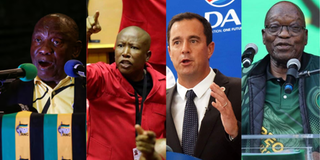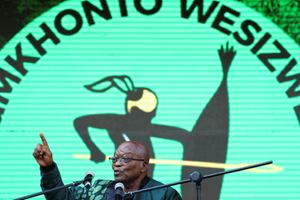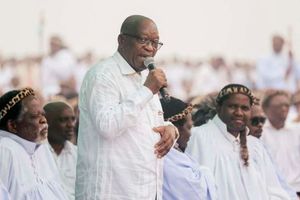
South Africa President Mr Cyril Ramaphosa and the main opposition leaders: Julius Malema of the Economic Freedom Fighters (EFF) John Steenhuisen of the Democratic Alliance (DA), and Jacob Zuma of uMkhonto we Sizwe (MK).
This coming Wednesday, South Africa’s ruling African National Congress (ANC) faces what is set to be the greatest test in its 112-year history.
The ‘party of Mandela’, based on the latest and most extensive likely voter polls, is for the first time since taking power under Nelson Mandela in 1994, on course to win substantially less than 50 per cent of the total votes cast.
If so, the outcome of this week’s elections – almost universally considered the most important since 1994 – will put the fate of the ANC, and by extension and in some degree, that of the country, into the hands of political groupings deeply opposed to the ANC, either at policy level or that of its leading figures.
The newly-formed uMkhonto weSizwe (Spear of the Nation) party, which was set up late last year as a vehicle for disenchanted former ANC supporters and which has since become ‘the party of Zuma’, with the corruption-accused former President’s face on its posters and next to its name on the ballot papers, may well emerge as the fourth, or even, by some assessments, third largest party, making it a regional kingmaker, perhaps even so nationally.
But that would be seen both internally and externally as likely a highly negative development for those attempting to rebuild South Africa’s much-damaged economy and status as a major industrial base in Africa for international investors.
Democratic Alliance
What would work for investors and the property-owning middle class would be a much-weakened ANC reliant in key regions and maybe also nationally on a ‘moderate’ pro-business party such as the current official opposition, the Democratic Alliance.
But the masses of the poor are demanding change, and are deeply disillusioned with non-delivery on longstanding promises from the ANC.
With literally dozens of new parties and even independent candidates running nationally and regionally, there are many choices, but few obvious winners, even in places like Zulu-dominated KwaZulu-Natal, where Zuma and his party MK enjoy around quarter of pre-election support, as surveyed.
Instead, South Africa looks set for a ‘season of unstable coalitions’, something the country has already had a foretaste of since 2021 when some metros had no clear winning party, and which is therefore not generally-speaking a desired outcome, even for those set on change at all costs.
This scenario sets the scene for one of two major directions, post-elections: Either the ANC is forced into a ‘working alliance’ with another party, or parties, it ‘does not like’ but which it must tolerate, or it will form something similar, though likely even less stable, with opponents it cannot trust.
In 2021, the ANC lost its overall majority of votes cast in local government elections, dropping by over eight percentage points from its previous showing five years prior, to 45.59 per cent.
The ANC consequently lost control of several major metros, including Johannesburg and the administrative capital Pretoria, which resulted in upheavals, sides-switching, game-playing and revolving collectives of unstable alliances, usually formed to get the ANC’s main urban rival, the Democratic Alliance, out of positions of power.
This time, the ANC fall-off of support is expected to be bigger yet – though Ramaphosa and his team insist they expect to get an overall majority.
Five years ago, the ANC garnered 62.15 per cent, or 249 seats out of 400 in the National Assembly.
At the time, analysts held that, based on relatively newly-installed ANC leader President Cyril Ramaphosa, who was personally polling as the country’s then most popular leader in his own right at about 70-72 per cent, had provided the ANC with a 5-10 percent lift from its background support levels. This time, things are very different.
A year ago, amid the worst power outages the country has yet experienced – the issue being emblematic of the ANC’s failings in government since 1994, and heavily offsetting what social and other gains had accrued to ordinary citizens since apartheid was tossed aside – Ramaphosa’s personal popularity was rated at just over 40 percent (59 percent among ANC supporters).
This time, it is Ramaphosa himself also being held to ‘blame’ for a long list of problems facing the ANC: a weak economy showing no signs of improvement anytime soon, record unemployment, poor to non-existent government service delivery, and a sense that the government exists to provide cushy jobs for connected pals, while most people struggle to live.
South Africa’s growth outlook for 2024 is barely at 1.0 per cent, but that is still double 2023's extremely weak performance.
While many African countries have bounced back from Covid and are showing healthy growth, South Africa as the most industrialised African state is not doing nearly so well. And most blame the ANC for that.
But who to choose instead is much trickier for the average voter. The formation of uMkhonto we Sizwe in the 1950s by Mandela and other young firebrands marked a different sort of turning point – from that time on, apartheid was always on the back foot, its proponents on the defensive and, as it turned out, fighting a losing war.
It took, however, another 40 years for domestic and international developments to reach the point where the National Party, which came to power in 1948 on an overtly racist agenda, was thrown out.
Poor economic conditions
In the 30 years since, the ‘South African miracle’, which saw off an impending extra-violent raced-based civil war, plus a possible civil conflict on almost the same scale between Zulu traditionalists and ANC ‘modernists’, has soured by degrees such that the once-vaunted ‘Rainbow Nation’ hardly exists, but in historical references to Mandela’s five-year term as President in the 1990s.
With the ANC in decline, there is an opportunity for new alignments to form, but these will tend to be on the fringes, rather than dominate a reformed political landscape. MK and Zuma, despite being ‘new’, are a fairly well-measured factor looking to land between 11 and 15 per cent of the total vote.
Alone, MK and Zuma could easily provide the ANC with the support it lacks nationally and in key provinces for such an alliance to work – except that MK with Zuma at its head, whether on the ballot himself or off it, as the Constitutional Court ordered this week, exists largely as rejection of the ANC, especially with Ramaphosa as its leader.
‘Zuma and Co’ are also even more radical than firebrand Julius Malema and his Economic Freedom Fighters (EFF), assessed in likely voter polls at heading towards about 11.5 per cent of the total vote.
Malema, in one of his longest and most detailed interviews with foreign media, said he and his EFF were ‘Marxist-Leninists’, in the classical definition, who hold that effectively all land is owned by the state and that all enterprises, including banks and the Reserve Bank, be nationalised, should that party achieve power.
Despite poor economic conditions in recent years, South Africa’s current GDP is three times what it was in 1994, meaning there has been growth of an emergent ‘black’ middle class, albeit it not enough to maintain the ANC’s broad popularity from the days when it commanded two-thirds of the vote, or more.
Voter support
For these folks, with property, jobs, cars and a stake in the economy, the EFF is too radical, that party having reached, by some assessments, a ‘natural ceiling’ of likely voter support, perhaps topping out in the mid-teens.
The DA, for its part, has realised that it too has topped out at around 20 and a few per cent, and that real penetration into the pool of urban and rural disenchanted voters can only come in combination with a clutch of some 10 smaller parties, collectively praying for a majority but, realistically, likely to get between them around 22.5 per cent of the vote.
Adding the likely support for the top four parties, including those tying their wagons to the DA’s ‘moonshot’ bid to oust the ANC with the help of a collective of opponents, puts the total available to other parties at not much.
Assuming the ANC falls in the middle of its projected performance range at 45 per cent, the DA and Co getting half that, MK and Zuma coming in at around 15 percent and the EFF at around 12-15 per cent, that leaves very little scope no matter how many new players there may be on the ballot papers.
Another Zulu traditionalist outfit, in some ways loosely similar to MK, is the Inkatha Freedom Party, once an ally of the ANC, later in the 1980s and 90s an arch-enemy, fighting pitched battles in the rolling green hills of KwaZulu-Natal and high-density hostel settlements for migrant workers around Johannesburg.
Though making a comeback from near annihilation at the polls, Inkatha’s role, even in its home province of KwaZulu-Natal, will be on the fringes, perhaps in some regions part of a larger alliance against the ANC.
All the rest of the dozens of new parties and would-be state or regional leaders, look to be picking at the scraps of the balance of the vote, likely less than 10 percent between them.
Increased instability
Even if the ANC scrapes back into power, perhaps with the help of a few smaller parties sufficient to gain it a hair over 50 per cent, it is by no means clear that it will suddenly reform itself into a party with regained momentum and broadening support, despite Ramaphosa’s openly espoused desire towards that goal.
More likely, there will be increased instability with more coalitions in more areas and more voter disgruntlement to follow.
The vote on Wednesday may not therefore necessarily mark the point at which the ANC, historically speaking, may be said to have fallen from power.
But it could easily be the last election after which the ANC can, on its own or with the support of a couple tiny parties, continue to govern.
Which party or collective of parties will mark out South Africa’s future development is another issue altogether, with much turmoil almost certain to come – and with the real final fall from grace awaiting another date or two of the voters and their choices.
That there is already so much dissatisfaction that many have lost all political hope is clear: Of 62 million people, only 27.79 million have registered to vote.
Voting enthusiasm in South Africa has been dropping sharply for at least a decade.
In the 2014 South African parliamentary elections, turnout (those who actually voted) was just 54 per cent.
In the 2019 elections, the trend was even more obvious at 47 per cent – among the lowest in the world.
In the end, therefore, it will be those who bother to vote at all, and how many stay away, who may play the biggest roles in deciding the lay of the political landscape in South Africa for the next five years.








